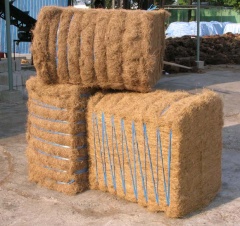Fibres
| Infobox on Fibres | |
|---|---|
| Example of Fibres |  |
| Facts | |
| Origin | - |
| Stowage factor (in m3/t) |
|
| Humidity / moisture | See text |
| Ventilation | - |
| Risk factors | See text |
Fibres
Description
Fibres are a class of hair-like materials that are continuous filaments. They can also be matted into sheets to make products such as paper or felt. Fibres are of three types: natural fibre which consists of animal and plant fibres, and man made fibre which consists of synthetic fibres and regenerated fibres.
Natural fibres are made from plant, animal and mineral sources. Natural fibres can be classified according to their origin.
Vegetable fibres are generally composed mainly of cellulose: examples include cotton, jute, flax, ramie, sisal, and hemp. Cellulose fibres serve in the manufacture of paper and cloth.
Animal fibres generally comprise proteins such as collagen, keratin and fibroin; examples include silk, sinew, wool, catgut, angora, mohair and alpaca.
Application
After World War II, the build-up of synthetic fibres significantly decreased the use of natural fibres. Now, with the increase of oil prices and environmental considerations, there has been a revival of natural fibre use within the textile, building, plastic and automotive industries. This interest is reinforced by the developmental perspectives on the agro-industrial market and local productions, allowing economic development and independence versus imported materials.
Shipment / Storage
All natural fibres have a moisture content which varies with the relative humidity of the atmosphere, and the main cause of damage to this class of fibre is the effect of excess moisture over and above the natural regain. Damage can be bacterial or chemical and can be due, among other things, to contact with liquid, water or soil, with rusting metal, or the presence of acids or by actine degradation. In the case of fibres which are press-packed in bales, the presence of excess moisture will normally lead to what is called ‘heart’ damage, which starts in the middle of the bale and extends outwards. The moisture content of the fibres can change in transit, either due to the loss of natural moisture or to absorption; the maximum moisture that can be absorbed from the atmosphere is different for each cellulosic fibre and can be approximately stated in each case. It will normally be lower than would be found after direct contact with fresh or salt water. The quantity of salt present in damaged fibre may give some indication as to whether the cause was direct contact wilt salt water or normal contamination during fibre treatment. A test of chlorides should be made from both sound and damaged material.
It is essential that bales damaged by moisture be opened and dried with the minimum of delay to avoid further damage.
Natural fibres which have been inadequately separated from the original stem or leaf may be more prone to rotting, and fibre so damaged will be discoloured and of low strength, the bales giving the appearance of having been stored in the open air or on damp ground. Discolouration of fibre can occur where it is stored close to or in the proximity of other commodities containing excess moisture. Most cellulosic fibres are liable to the growth of moulds and fungi, and the contents of bags made from these materials may also be adversely affected. Certain fabrics and ropes are proofed against mildew or rot to increase their resistance on exposure to moisture.
Fibre which has become useless for the purpose intended might well find an alternative market.
Risk factors
Reference is made to the relevant IMO regulations on hazardous cargo.











